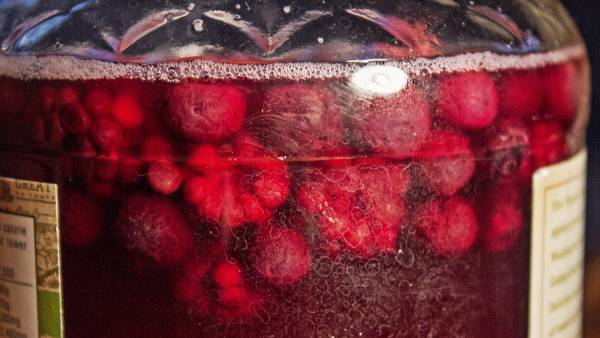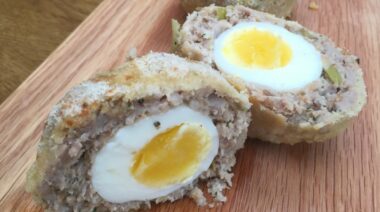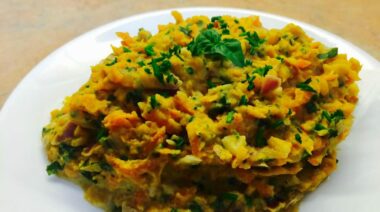You’ve probably heard people talking about this drink called kombucha. What the heck is it, and why would you want to drink it?
Let’s make one thing clear: science hasn’t found any conclusive benefits to drinking kombucha. But this isn’t to say that there are no benefits. A quality kombucha has beneficial bacteria and should be quite healthy, in theory. Unfortunately, the studies to prove it just don’t exist.
But I still like it, for reasons I will explain. First, let’s go over some of the basics.
Kombucha 101
Kombucha is a drink that is made by fermenting tea. It makes sense that it would be so popular, given all the recent buzz about fermented foods and gut health. Usually black tea is used, although you can also use a blend of different teas. The tea is brewed hot, sugar is added, and a SCOBY is placed on top.
A SCOBY stands for “symbiotic culture of bacteria and yeast.” Basically, it is a jellyfish-looking mixture of bacteria and yeast that forms a cellulose layer to keep the culture protected. People often mistake a SCOBY for a mushroom or fungus. Really, it’s simply a sugar-eating machine.
This fungus-looking glob is the secret to making high-quality and delicious kombucha.
When the SCOBY is placed on top of the tea and sugar mixture, it is covered with a cloth and left to ferment. The bacteria eat up the sugar and forms an acid, much like a hard cider. Different brewing methods produce varying levels of carbonation. Flavors are often added, such as ginger, turmeric, fruit, and green algae.
You can make kombucha yourself or buy it in stores. One of the reasons that kombucha is popular is that these commercial brands are available. Once refrigerated, the “bucha” stops fermenting and can last quite a long time before consumption.
A Cure-All or Simply a Delicious Drink?
I’ve heard claims that kombucha is good for just about every ailment. However, since the scientific verdict is still out, I will tell you what I have noticed.
- Energy Levels: Kombucha gives me a good amount of energy. Perhaps this could be a caffeine effect, although when I drink equivalent amounts of caffeine in other beverages, I don’t feel as much energy.
- Water Weight: Another benefit I have noticed is that drinking kombucha makes me urinate more often. Strikingly more often, actually. It may be the acidity or something else, but it could help if you need to lose some water weight. Again, this isn’t anything scientific, just observations.
- Connection: Convenience has its benefits, but we’ve also lost touch with the food-making process. Brewing my own kombucha gives me an opportunity to feel connected to something. I can say brewed it myself by manipulating a bacteria culture. It’s pretty cool.
- Kick Your Soda Habit: Since kombucha is carbonated and strong, it can serve as a nice way to get off soda. Not only does kombucha have the strong flavor and caffeine you get from soda, but it is also a more nutritious option.
The drawbacks to kombucha are a few cases of reported illness. You have to be careful with fermented foods, since they are left out at room temperature to brew. Mold can easily grow in the same environment. So your SCOBY source certainly matters. Nevertheless, even with increasing popularity and more commercial brands, there have not been any widespread issues. Just make sure you know what to do and what to look for if you’re going to do a home brew.
As a precaution, I would advise anyone with a compromised immune system or who is pregnant to avoid kombucha or get medical permission. Kombucha is also an acidic beverage, so drinking with a straw would be helpful if your teeth are sensitive.
How to Make Your Own Kombucha

Making kombucha is quite simple once you get comfortable with the process. Here’s how to do it:
Supplies:
- A SCOBY. You can ask around locally, or shop for it online. Usually people who have been brewing a long time have extra ones on hand.
- A jar or barrel with a wide top. Narrow tops will limit the oxygen flow to the mixture.
- Something to cover the jar. Many people use cheesecloth, but it allows fruit flies to get in and ruin your batch. Use an old t-shirt to cover the jar.
- 15 cups water
- 3-5 Tablespoons of tea
- 1 cup vinegar
Method:
- Bring 15 cups of filtered water close to a boil, and let about 3-5 tablespoons of tea brew for 5 minutes. You can use a mixture of teas, but start with a black tea to keep it simple.
- Mix in 1 cup of sugar and stir.
- Once the mixture cools to room temperature, you can use it. Rub your hands in vinegar to kill bacteria, then pour your tea and sugar mixture into the jar, not quite full.
- Place the SCOBY on top, and cover.
- Let it sit in a dark place. Ideally, the temperature in your house is in the low 70s. The speed at which the kombucha will brew is affected by the temperature. The cooler it is, the slower it goes.
Wait about a week before testing. If you like your kombucha stronger or more tart, give it more time.
Toast to Your Health
There are many different brewing methods, but I wanted to give you an overview of the basics. Making your own kombucha will save you quite a bit of money, and it’s also a lot of fun. And of course, it makes for a great conversation starter when people come over and see a huge barrel with a strong, fruity odor.
Kombucha isn’t a savior of health, but can be part of a healthy diet. But don’t drink it just because you think it will change your health. Experiment, try different flavors, and most of all – enjoy.
More Fermentation Facts:
- The Real Reason Your Gut Needs Fermented Foods
- DIY Fermented Foods: Easy Homemade Yogurt
- DIY Fermented Foods: Homemade Sauerkraut
- New on Breaking Muscle Right Now
Photo 1 courtesy of Marc Halpern.
Photo 2 courtesy of Lukas Chin.






